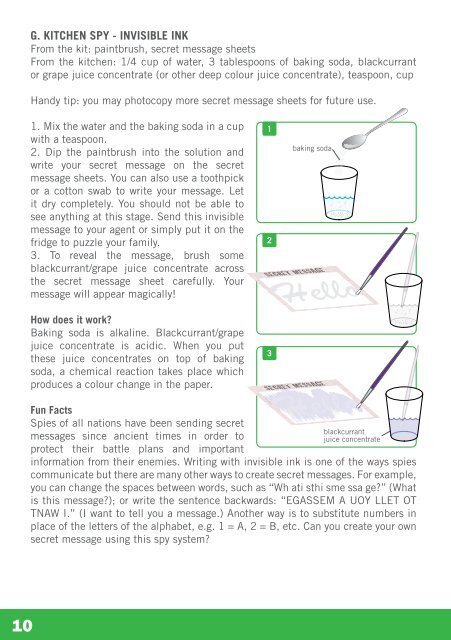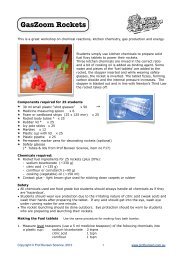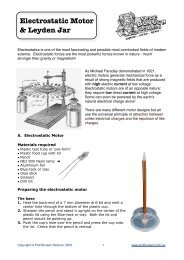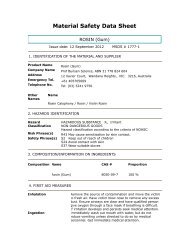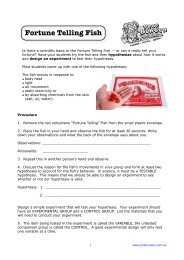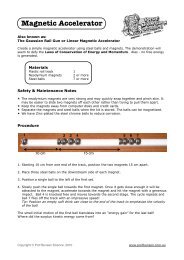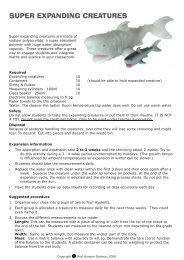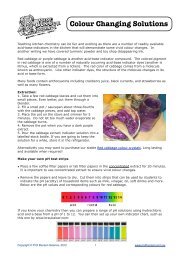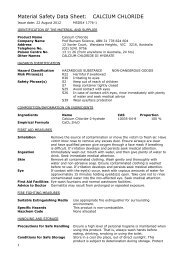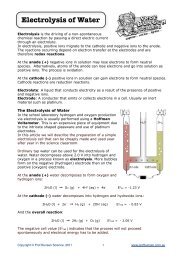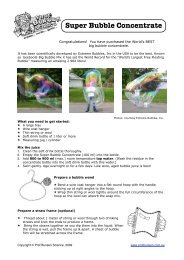A. SAFETY MESSAGES B. CONTENTS - Prof Bunsen
A. SAFETY MESSAGES B. CONTENTS - Prof Bunsen
A. SAFETY MESSAGES B. CONTENTS - Prof Bunsen
You also want an ePaper? Increase the reach of your titles
YUMPU automatically turns print PDFs into web optimized ePapers that Google loves.
G. KITCHEN SPY - INVISIBLE INK<br />
From the kit: paintbrush, secret message sheets<br />
From the kitchen: 1/4 cup of water, 3 tablespoons of baking soda, blackcurrant<br />
or grape juice concentrate (or other deep colour juice concentrate), teaspoon, cup<br />
Handy tip: you may photocopy more secret message sheets for future use.<br />
1. Mix the water and the baking soda in a cup<br />
with a teaspoon.<br />
2. Dip the paintbrush into the solution and<br />
write your secret message on the secret<br />
message sheets. You can also use a toothpick<br />
or a cotton swab to write your message. Let<br />
it dry completely. You should not be able to<br />
see anything at this stage. Send this invisible<br />
message to your agent or simply put it on the<br />
fridge to puzzle your family.<br />
3. To reveal the message, brush some<br />
blackcurrant/grape juice concentrate across<br />
the secret message sheet carefully. Your<br />
message will appear magically!<br />
How does it work<br />
Baking soda is alkaline. Blackcurrant/grape<br />
juice concentrate is acidic. When you put<br />
these juice concentrates on top of baking<br />
soda, a chemical reaction takes place which<br />
produces a colour change in the paper.<br />
Fun Facts<br />
Spies of all nations have been sending secret<br />
messages since ancient times in order to<br />
protect their battle plans and important<br />
baking soda<br />
SECRET MESSAGE<br />
blackcurrant<br />
juice concentrate<br />
information from their enemies. Writing with invisible ink is one of the ways spies<br />
communicate but there are many other ways to create secret messages. For example,<br />
you can change the spaces between words, such as “Wh ati sthi sme ssa ge” (What<br />
is this message); or write the sentence backwards: “EGASSEM A UOY LLET OT<br />
TNAW I.” (I want to tell you a message.) Another way is to substitute numbers in<br />
place of the letters of the alphabet, e.g. 1 = A, 2 = B, etc. Can you create your own<br />
secret message using this spy system<br />
1<br />
2<br />
3<br />
SECRET MESSAGE<br />
H. FRUIT BATTERY<br />
From the kit: 2 zinc plates, LCD watch movement, connection wire, adhesive tape<br />
From the kitchen: 2 forks, 1 lemon - halved (or other fruits, e.g. apple, tomato)<br />
1. Connect the red wire on the LCD watch to a fork and the black wire to a zinc plate.<br />
Secure the wires in place with adhesive tape.<br />
2. Get another fork and zinc plate and connect them with the connection wire using<br />
adhesive tape.<br />
3. Insert the forks and zinc plates into the lemon halves to activate the LCD watch<br />
movement as shown in the diagram. You will see your watch start blinking.<br />
2<br />
Adhesive tape<br />
3<br />
zinc<br />
connection wire<br />
How does it work<br />
The forks act like the positive electrodes of a battery. They are plated with a metal<br />
which is less reactive than zinc. When the forks and zinc plates are inserted into<br />
the lemon, a chemical reaction takes place. Electrons (extremely small particles<br />
with negative charge) move from the zinc plates to the forks to form a current, thus<br />
activating the LCD watch. The lemon juice helps to conduct electricity. You can<br />
replace the lemon with a potato, a grapefruit or use soft drinks and see what effect<br />
this has.<br />
Fun Facts<br />
The development of the battery started in 1775 when a scientist called Alessandro<br />
Volta invented a machine that produced and stored static electricity by rubbing cat<br />
fur across a metal plate. A few years later, a doctor called Luigi Galvani noticed<br />
that dissected frogs’ legs twitched when they were in contact with two different<br />
metals. Volta realised that the electricity came from the metals and began doing<br />
experiments with different types of metal. In 1800, he made the first ever battery<br />
which consisted of copper and zinc strips separated by a piece of paper soaked in<br />
salt water and dipped in diluted acid.<br />
1<br />
zinc<br />
10 11


